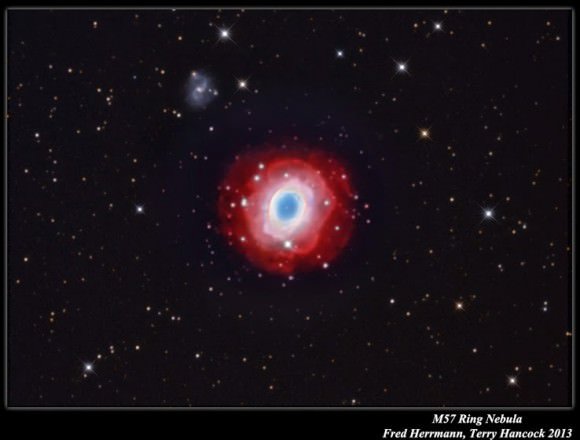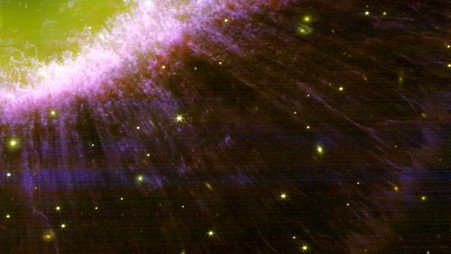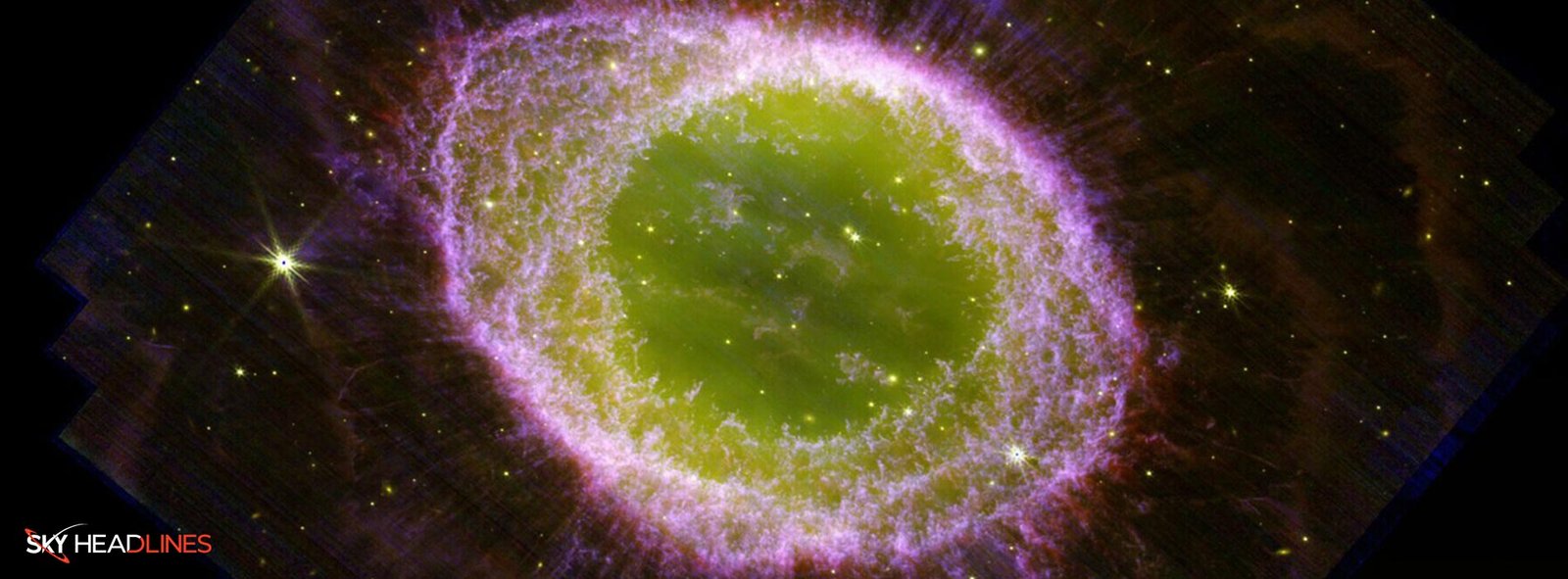Its the time to see some breathtaking views of the iconic Ring Nebula with the JWST! They have just revealed the stunning infrared image of this nebula. And it also entails beautiful details which are phenomenal.
What is the Constellation of Ring Nebula & What Does it Represents?
If we talk about the constellation of ring nebula, then it lies in the constellation Lyra. And it represents the left particles of a sun-like star’s death. And this star has a center that is expels its all materials into the space. Which is a very awe-inspiring phenomenon. When it does this, it creates the remarkable ring formation that we observe. Which results a star in undergoing transformation in a white dwarf.
But here arises a question. That what does the death of this star holds, and how it could provide benefits for scientists? So, the particular form of star death has left astronomers in awe for a long time. Since it provides a glimpse into what our own Sun will experience in approximately 5 billion years.
How Does Astronomers Professors & Astrophysicists Expressed Their Joy by Seeing Ring Nebula?
Albert Zijlstra, is a Professor of Astrophysics at the University of Manchester. Also expresses his excitement about the ring nebula, and the JWST view. He, thus said:
“The images have left us in awe, giving us knowledge about anything we’ve seen before. We always knew planetary nebulae were stunning. But what we witness now is simply spectacular!”
Aside from this, here we will also be quoting another statement by Jan Cami!
He is an astrophysicist. He mentioned:
“As a kid, I gazed at the Ring Nebula through a small telescope. Little did I know that one day, I’d be part of a team using the most powerful space telescope ever built to observe this very object.”
Besides Jan Cami, let’s see see another quote by Mike Barlow. He is an astronomer and co-lead scientist of the JWST Nebula’s Ring Imaging Project from University College London.
He said:
“We are witnessing the final stages of a star’s life. Offering us a glimpse into the Sun’s distant future. JWST’s observations have opened a new window into understanding these captivating cosmic events.”
What are Some Diverse Shapes of Planetary Nebulae?
If you want to know more about the planetary nebulae, then let us drive you through some more interesting information. The Planetary nebulae scatter across the galaxy. And not just scattering, each one of them boasts unique characteristics with diverse shapes. That is why some exhibit bright rings, while others flaunt bubble-like formations. Aside from this, they also resemble butterflies and ethereal wisps.
Jelly Donut & Bagel Shaped Ring Nebulae:
And besides planetary nebulae, the ring nebula has a more intriguing similarity to a jelly donut or bagel. If we talk about its shape, then it resembles donuts. But, here arises the question that how it gives us captivating hints about its history.

The next part of the blog is solely related to answering this question, so hang on, and keep reading!
What Details Have been Revealed by Ring of Nebulae So Far?
To uncover the secrets within these celestial wonders, many astronomers deeply study the light emitted by planetary nebulae. And when they go through this process, they can trace the chemical elements present within them, by delving into the intricate details of these elements. We will have a pretty knowledge about the remarkable story of a star’s evolution over time.
And to do this particular investigation, JWST is focusing on the ring using its NIRCam instrument. Which is highly sensitive to near-infrared light spanning from 0.6 to 5 microns (600-5000 nanometers). As the human eye can only detect a bit of infrared light up to around 0.7 microns (700 nm). That is why JWST gives us a broad vision to understand the nature and universe.
Life Cycle of Stars has been Expressed by Nebula Ring:
Mike Barlow is the lead scientist of the JWST. He emphasized how the high-resolution views provide a wealth of information about the Ring’s journey through its life cycle.
He shared:
“These detailed images not only unveil the intricate aspects of the nebula’s expanding shell but also offer a clear view of the inner region around the central white dwarf. Witnessing the final stages of a star’s life gives us a preview of the Sun’s distant future, so to speak. JWST’s observations have truly opened a new window into comprehending these awe-inspiring cosmic events. Moreover, the Ring Nebula also acts as an informative tool for studying the formation and evolution of planetary nebulae.”
A Diverse of Colors in Ring Nebula:
The captivating view of the Ring Nebula captured by JWST presents a wealth of valuable information. By analyzing the colors representing temperatures of ejected material at varying distances from the star, astronomers gain insights into the nebula’s composition and dynamics.
The captivating glow produced by gas and dust clouds is heated to approximately 100,000 degrees. And this is done by their star. It is an indicator of past and future changes within this nebula. It also provides us with knowledge of its history and evolution.
If we do a rough estimation that this process started around 4,000 years ago. Then, its ending provides us with a conclusion. And it gives us valuable insights into the final stages of a star’s life.

JWST’s infrared-sensitive capabilities enable astronomers to penetrate even further into the Ring Nebula than previously possible, surpassing dust clouds’ limitations and providing unprecedented access to its intricate features. Meanwhile, NIRCam allows scientists to closely examine its structures; providing clearer insight into their inner workings than before. Furthermore, infrared emitting material detection enhances these observations, giving way to new understandings of this mysterious object’s intricate details.

What Could the Potential Information May be Provided by Ring Nebula in Near Future?
As we all know that JWST makes scientific discoveries, and inventions daily. That is why we can prospect some interesting further insights about the Ring Nebula. Moreover, the telescope’s capability to delve into the nebula’s edges will further examine the delicate details too.
This would be a fortune collaboration of international researchers from diverse countries too. As they hold great promise in advancing our knowledge about the star cycles, and the formation of the Universe. Henceforth, the anticipation of near future findings will give science fuel that will further help out in clearing a vision about our understanding of the Universe, galaxies, and stars. Now, what do you think about it? Let us know in the comments section below.





